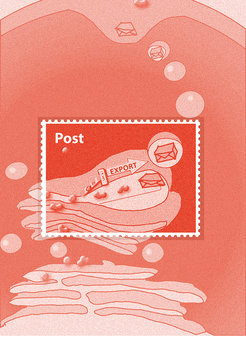Proteins for export – cellar distribution centre

For certain proteins outside the cell to reach their destination, they are packed in small vesicles in the cellular distribution centre and guided to the cell surface.
The Golgi Apparatus in cells is often referred to as a post office. The proteins, which assume vital tasks in the cells like small machines, have to be guided to specific destinations following their synthesis. A very wide range of proteins are sorted and packed in vesicles, that is small fat bubbles, in the Golgi apparatus.
In addition to the resident proteins, which assume functions within the cell, numerous messenger substances or support proteins exist which are deployed outside the cell. Julia von Blume from the Max Planck Institute of Biochemistry has been working for a long time on how the proteins, which have be packed and trafficked outside the cell, can be identified. She has studied the COMP and LysC proteins in particular: COMP is a protein that has contact with collagen outside the cell.
Together with her research team, Julia von Blume has now succeeded in demonstrating that calcium and Cab45 are necessary for the functioning of the sorting mechanism within the Golgi apparatus. The calcium signal, which flows via the small SPCA1 pump, causes the Cab45 protein to accumulate from many individual parts. “This happens in a particular area of the Golgi apparatus,” explains von Blume. “So we could say that we have discovered the ‘export department’ in the cellular distribution centre as the accumulated Cab45 only binds proteins like COMP and LysC in the areas known as microdomains.” The proteins are then packed in small vesicles and guided to the cell surface.
In the next stage of their research, the scientists would like to establish whether the calcium level must be deliberately reduced again to enable the release of Cab45 by COMP and LysC or whether a different mechanism is involved here. “I would ultimately like to understand each individual step in the transport process required to convey the proteins to their destination,” says von Blume summarizing her long-term research objective.
Original publication:
A. H. Crevenna, B. Blank, A. Maiser, D. Emin, J. Prescher, G. Beck, C. Kienzle, K. Barntnik, B. Habermann, M. Pakdel, H. Leonhardt, D. C. Lamb, J. von Blume: Secretory cargo sortin by Ca2+-dependent Cab45 oligomerization at the trans-Golgi Network. Journal of Cell Biology, May 2016
DOI: 10.1083/jcb.201601089



